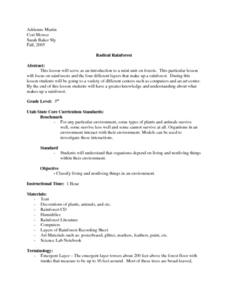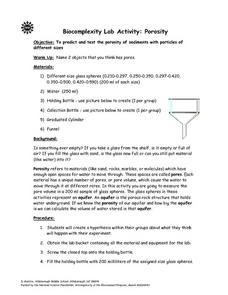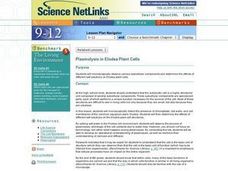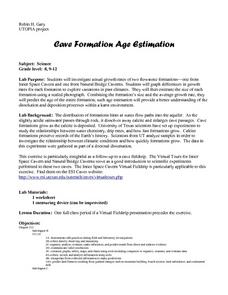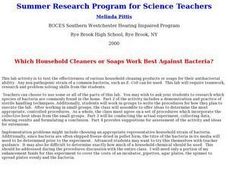Curated OER
Dust in the Wind
Young scholars investigate causes and effects of droughts by participating in a simulation 'town hall meeting.' Acting as community members, students make informed decisions to help a town and its surrounding areas suffering effects of a...
Curated OER
Native Species Restoration and its Impact on Local Populations
Students explore how predators help control the growth of prey species for a more balanced ecosystem.
Curated OER
Can Acid and Bases Remedy the Body?
Students experiment with acids and bases using technology-based "probe-ware", computers, and household products in this exciting biology/chemistry lesson. The lesson was written for an advanced 6th grade class.
Curated OER
Asexual versus Sexual Reproduction
Students explore reproduction. They research organisms and groups of organisms to determine whether they reproduce sexually or asexually. In addition, they determine the organism's habitat.
Curated OER
Plants: Scattering Seeds
Middle schoolers collect and microscopically examine seeds from the school yard and neighborhood. In small groups, they draw and discuss the shapes of the seeds to determine each plant's method of dispersal. they also test two types of...
Curated OER
Identifying Vertebrates
In this biology worksheet, students look for the answers to how to classify animals. They specifically focus upon the vertebrates while differentiating the characteristics from other organisms.
Curated OER
Graphing Toad/ Frog Respiration
Learners measure respiratory rates on live toads, and the effect water temperature has on their findings. In this scientific method lesson plan, students record their findings and present them in a graph, comparing the results.
Curated OER
Seed Dispersion of Strawberries and Dandelions
Students investigate how seeds are dispersed on land. In this plant biology lesson, students use a dissecting microscope to study strawberry seeds and dandelion seeds, they draw what they see, then create a hypothesis on the seeds...
Curated OER
Machines: Designing Form and Function
Learners design a boat model with simplified steam engine. In this ecology lesson, students compare renewable and nonrenewable energy sources. They determine the efficiency of their boat model.
Curated OER
Oil Spills
Third graders examine the San Francisco oil spill and the effects it has had. For this investigative lesson students view a demonstration on oil clean up and how it works. They see how wildlife is rehabilitated, how the oil...
Curated OER
Is Your Water Clean?
Young scholars compare water quality of different sources. They test water samples for odor, phosphates, pH, bacteria, and dissolved solids. they fill out a data table and answer questions about their findings.
Curated OER
Radical Rainforest
Third graders examine rainforests and the four different layers that make up a rainforest. They create an advertisement poster advertising a trip to the rainforest, including information concerning why people should visit, as well as,...
Curated OER
Biosphere
Students examine the basic biosphere and its components. In this ecology instructional activity students complete several experiments including designing a system that is balanced to sustain life.
Curated OER
Corrosion & Rust
Students examine how and when rust and corrosion occur. In this corrosion lesson students complete an experiment to see why metals rust.
Curated OER
Salinity in Mill Creek
Fifth graders use water samples collected at three different locations of Utah's Mill Creek to test salinity of water, hypothesize about salinity levels at each location, record results, and discuss their findings with classmates. ...
Curated OER
National Park Project
Learners develop a descriptive and informative brochure for a National Park. They focus on the history and geology of the park, environmental concerns, and visitor actions that could eliminate the environmental concerns.
Curated OER
Com-Post With Us? Learn About Recycling While Having Fun
Students examine the importance of recycling to help the environment. In groups, they make a compost bin on the school grounds recording how the material changes from week to week. They collect other materials for recycling like cell...
Curated OER
Permeability and Porosity of Somerset County Sediments
Students predict and test the permeability and porosity of sediments in Somerset County, New Jersey. They discuss what how porous they think the sediment of HMS grounds is and why. Students walk around the HMS campus and collect six...
Curated OER
Porosity
Students predict and test the porosity of sediments with particles of different sizes. They name two objects that they think has pores. Students define the term porosity and pores. They comprehend that an aquifer is the porous rock...
Curated OER
Plasmolysis in Elodea Plant Cells
Students microscopically observe various subcellular components. They determine the effects of different salt solutions on Elodea plant cells. Students explain the major function of a cell membrane and describe its structure.
Curated OER
Cave Formation Age Estimation
Students investigate growth rates of flowstone formations. They view a virtual field trip and discuss how flowstones form. They observe the cave fieldtrip and predict the growth rate for a cave formation. They graph growth rates and...
Curated OER
Soil Analysis Lesson Plan
Students practice calculating density and examine examples of the physical characteristics of soil. They solve a "crime" based on the evidence and laboratory investigations.
Curated OER
Which Household Cleaners or Soaps Work Best Against Bacteria?
Young scholars experiment to determine the efficacy of various household cleaning products and soaps as antibacterial agents. They work in groups to complete this four part instructional activity series which includes identifying...
Curated OER
Analysis of Lobster Claw Function. An Exercise in Biomechanics
Young scholars observe two chelae. They write three differences they observe in their notebooks. Students suggest a hypothesis which would explain these differences. They dissect the chela. Young scholars analyze the lobster claw as a...













